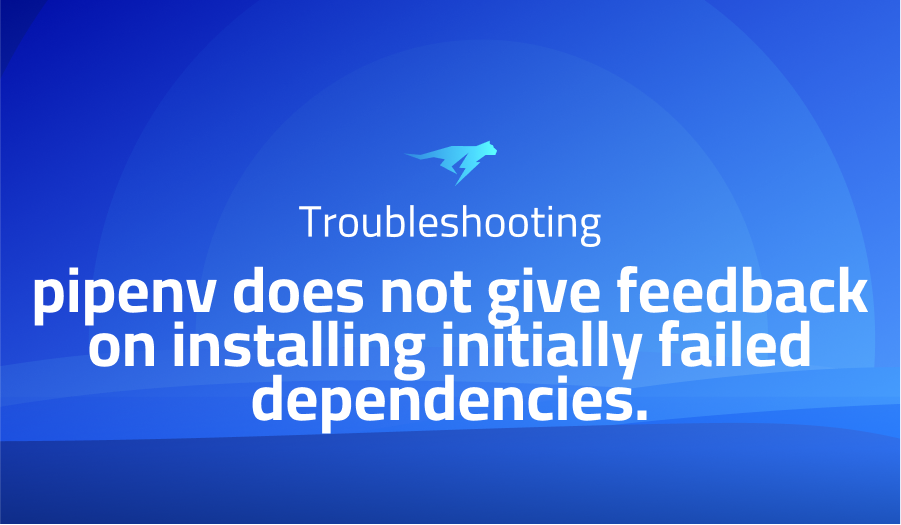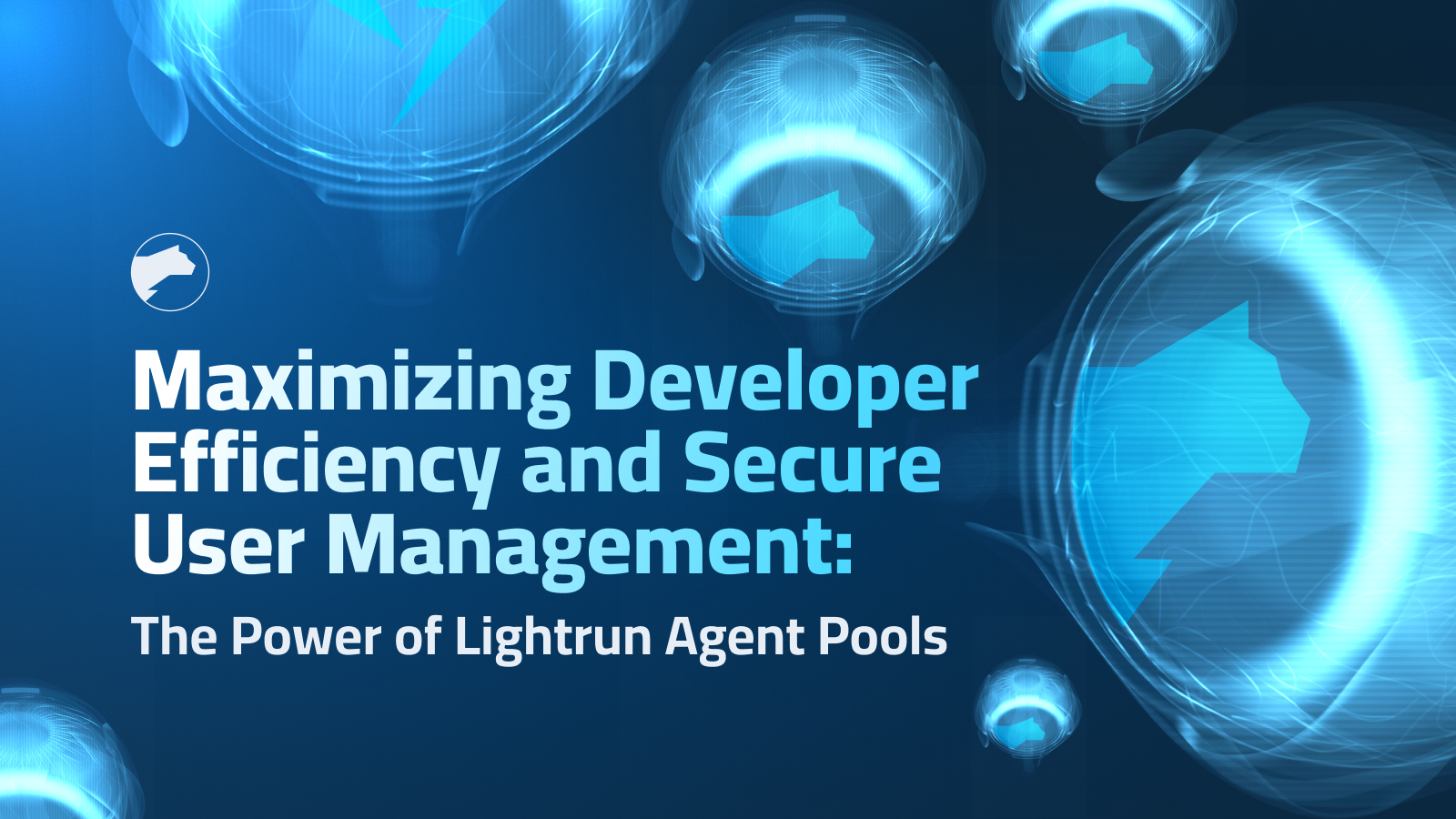

pipenv does not give feedback on installing initially failed dependencies.
Explanation of the problem
When attempting to install certain dependencies, specifically numpydoc==0.8.0 and overrides==1.9, using the latest version from the master branch of pipenv, I encountered a failure with the message “Will try again.” Although pipenv notified me that it was “Installing initially failed dependencies…” it did not provide any feedback regarding whether the installation was successful or not. The installation command used was pipenv install --python 3.7. The following is an excerpt from the installation log:
...
Installing dependencies from Pipfile.lock (53751d)…
An error occurred while installing numpydoc==0.8.0 --hash=sha256:61f4bf030937b60daa3262e421775838c945dcdd6e4854c7eb5ffd! Will try again.
An error occurred while installing overrides==1.9 --hash=sha256:91b59ac1f6f38aae1531f5d6111033b8f4d7e59330078202567963! Will try again.
...
Installing initially failed dependencies…
As shown in the log, the installation process indicated that it would try again for the failed dependencies, but it did not provide any conclusive information regarding the success or failure of the retry.
Troubleshooting with the Lightrun Developer Observability Platform
Getting a sense of what’s actually happening inside a live application is a frustrating experience, one that relies mostly on querying and observing whatever logs were written during development.
Lightrun is a Developer Observability Platform, allowing developers to add telemetry to live applications in real-time, on-demand, and right from the IDE.
- Instantly add logs to, set metrics in, and take snapshots of live applications
- Insights delivered straight to your IDE or CLI
- Works where you do: dev, QA, staging, CI/CD, and production
Start for free today
Problem solution for: pipenv does not give feedback on installing initially failed dependencies.
To address the issue of not receiving clear feedback on the success or failure of dependency installations when using the latest version of pipenv, there are a few steps you can take:
- Update pipenv: Ensure that you have the latest version of pipenv installed. You can do this by running the following command:
pip install --upgrade pipenv
- Retry the installation: Run the
pipenv installcommand again to attempt the installation of the dependencies. Monitor the output for any error messages or indications of success. If the installation fails again without clear feedback, proceed to the next step. - Verify the installation: Use the
pipenv --venvcommand to check if the virtual environment was successfully created. This command displays the path to the project’s virtual environment directory. If the virtual environment exists, it indicates that the installation was successful. - Activate the virtual environment: If the virtual environment was created, activate it using the
pipenv shellcommand. This command activates the virtual environment and allows you to work within its isolated environment. Once activated, you can verify that the dependencies are correctly installed by using commands such aspip listto view the installed packages.
By following these steps, you can ensure that the dependencies are installed correctly and have clear feedback on the success or failure of the installation process. If the issue persists, it may be helpful to consult the pipenv documentation or seek assistance from the pipenv community to troubleshoot further.
Other popular problems with pipenv
Problem 1: Slow Installation with Pipenv
One common problem with Pipenv is slow package installation, particularly when dealing with large projects or a slow internet connection. This can lead to frustration and decreased development productivity. The slow installation can be caused by various factors, including network latency, dependency resolution, or inefficient caching.
Solution:
To address the slow installation issue with Pipenv, you can try the following solutions:
- Use a Local Mirror: Configuring Pipenv to use a local mirror for package downloads can significantly improve installation speed. This involves setting the
PIPENV_PYPI_MIRRORenvironment variable to the URL of the local mirror. For example:
export PIPENV_PYPI_MIRROR=https://your-local-mirror-url
- Clear Pipenv Cache: Pipenv caches downloaded packages to speed up future installations. However, an overly large cache can slow down the installation process. You can clear the Pipenv cache using the
--clearoption:
pipenv --clear
- Optimize Dependency Resolution: Pipenv performs dependency resolution based on the specified versions and constraints in the
Pipfile.lock. However, complex dependency graphs or conflicting requirements can lead to longer resolution times. To optimize dependency resolution, ensure that yourPipfilespecifies precise version constraints and avoids overly broad ranges.
Problem 2: Conflict Resolution in Pipenv
Another common problem with Pipenv is resolving conflicts between package dependencies. When multiple packages require different versions of the same dependency or have incompatible dependencies, Pipenv may fail to resolve the conflicts, resulting in installation errors.
Solution:
To resolve conflicts in Pipenv, you can take the following steps:
- Update Package Versions: Ensure that you have the latest versions of the packages specified in your
Pipfile. Run the following command to update packages:
pipenv update
- Adjust Version Constraints: Review the version constraints specified in your
Pipfilefor conflicting packages. Consider relaxing or tightening the version ranges to find a compatible set of dependencies. You can also use explicit versions to avoid ambiguity. - Use Pipenv’s Resolution Strategies: Pipenv provides different resolution strategies, such as
--preto allow pre-release versions or--skip-lockto skip resolving dependencies from thePipfile.lock. Experimenting with different strategies may help resolve conflicts in certain cases.
Problem 3: Pipenv Installation Errors on Windows
Windows users may encounter specific installation errors when using Pipenv due to differences in package management and system configurations.
Solution:
To address Pipenv installation errors on Windows, consider the following steps:
- Install Required System Dependencies: Ensure that the required system dependencies, such as Python and Visual C++ Build Tools, are installed correctly on your Windows machine. Refer to the official Pipenv documentation for the specific requirements.
- Use Python Launcher: On Windows, you can try using the Python Launcher (
py) to execute Pipenv commands. This helps ensure that Pipenv is using the correct Python interpreter and associated dependencies.
py -m pipenv install
- Use Python 3.7 or Later: Pipenv is designed to work best with Python 3.7 and later versions. If you are using an older Python version, consider upgrading to a newer version to avoid compatibility issues.
By following these solutions, you can mitigate common problems encountered while using Pipenv. However, it’s important to keep in mind that specific issues may require additional troubleshooting or consultation with the Pipenv community or official documentation.
A brief introduction to pipenv
Pipenv is a popular package manager for Python that aims to provide a streamlined and efficient workflow for managing project dependencies, virtual environments, and dependency resolution. It combines the functionality of pip (the package installer) and virtualenv (the virtual environment manager) into a single tool. Pipenv utilizes the Pipfile and Pipfile.lock files to define and track project dependencies, ensuring reproducible and deterministic installations.
One of the key features of Pipenv is its automatic creation and management of virtual environments. It automatically creates a dedicated virtual environment for each project, isolating the project’s dependencies from the global Python environment. This allows for a clean and controlled development environment. Pipenv also provides commands to activate and deactivate the virtual environment, making it easy to switch between different projects.
Additionally, Pipenv simplifies dependency management by introducing a more user-friendly syntax in the Pipfile. It supports specifying packages and their versions using concise and intuitive syntax, allowing developers to declare dependencies with precision. Pipenv also integrates with PyPI (Python Package Index) to fetch and install packages from the official repository. By leveraging the Pipfile.lock file, Pipenv ensures that the exact versions of dependencies are installed, providing reproducibility across different environments.
In summary, Pipenv offers a robust and convenient solution for managing Python project dependencies and virtual environments. With its combined functionality of pip and virtualenv, automatic virtual environment creation, and dependency resolution based on the Pipfile.lock, Pipenv simplifies the development workflow and helps ensure reliable and consistent installations of Python packages.
Most popular use cases pipenv
- Dependency Management: Pipenv excels at managing project dependencies by providing a straightforward and intuitive syntax for specifying dependencies in the Pipfile. Developers can declare dependencies along with their desired versions, enabling precise control over the package ecosystem. Here’s an example of declaring dependencies in a Pipfile:
[[source]]
url = "https://pypi.org/simple"
verify_ssl = true
name = "pypi"
[packages]
requests = "==2.25.1"
numpy = ">=1.19.0,<2.0.0"
[dev-packages]
pytest = "^6.2.4"
- Virtual Environment Management: Pipenv simplifies the management of virtual environments by automatically creating and isolating project-specific virtual environments. This ensures that project dependencies are installed in a dedicated environment, separate from the system-wide Python installation. Developers can easily activate the virtual environment using the
pipenv shellcommand, as shown below:
$ pipenv shell
Launching subshell in virtual environment...
...
(PyLT3-Akadaxte) $
- Reproducible Installations: With the help of the Pipfile.lock file, Pipenv enables reproducible installations of project dependencies. The Pipfile.lock file contains the exact versions of the installed packages, ensuring consistency across different development and deployment environments. When running
pipenv install, Pipenv reads the Pipfile.lock to fetch and install the specified package versions, guaranteeing that the project’s dependencies are identical across different environments. This promotes reproducibility and reduces the likelihood of dependency-related issues.
Overall, Pipenv provides a comprehensive solution for dependency management and virtual environment handling in Python projects. Its user-friendly syntax, automatic virtual environment creation, and support for reproducible installations make it a valuable tool for developers seeking a streamlined and reliable package management workflow.
It’s Really not that Complicated.
You can actually understand what’s going on inside your live applications.




